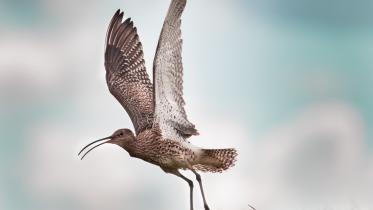
People urged to watch out for threatened waders
6 May 2024
Bird conservationists are highlighting the perilous position of Scotland’s wading birds and urging the public to help, as the first ever ‘Wader Week’ gets underway (6-12 May).
NatureScot has joined forces with Working for Waders – a partnership that aims to tackle the worrying decline of wading birds, such as curlew, lapwing and redshank – to raise awareness of the threats they face and show that declines can be reversed.
To improve understanding of the issues facing waders, people are being encouraged to help monitor the birds by completing the Working for Waders and British Trust for Ornithology’s Wader Calendar or by taking part in their Nest Camera project.
Waders are a group of birds typified by long legs and often a long bill. They come in a variety of sizes from the tiny ‘mouse-like’ sanderling, to the pretty hefty curlew. All the ‘Big Five’ farmland waders (curlew, lapwing, oystercatcher, redshank and golden plover) have been lost from historical parts of their breeding range in Scotland, with redshank, for example, retracting by a worrying 44% between surveys conducted in 1968-72 and 2008-12.
These same species have also suffered long-term declines in breeding numbers, with lapwing suffering a 62% decline between 1995 and 2021. Unfortunately, there is no sign of this trend slowing down as most of these species declined in the most recent part of that survey period (2016-2021), with both lapwing and redshank numbers falling by a whopping 10%.
Changes to agricultural practices and increasing numbers of ground predators have taken their toll on wader populations, due in part to the wader lifestyle, as NatureScot Ornithologist and Working for Waders Chair, Dave Parish, explains:
“The birds like to nest in open habitats such as moorland or agricultural grasslands, which can make nests vulnerable to destruction by livestock and farm machinery. Many farmers have a great deal of affection for these birds and will go to great lengths to protect their nests, ploughing round them, for example, and moving chicks if they can, but even with the best of intentions, this can be difficult and time-consuming work.”
Many wader-friendly areas are now also being targeted for woodland planting, and waders are not only directly displaced by forestry, but will avoid areas around forest blocks, often up to hundreds of metres away. To reduce this impact, NatureScot encourages forestry planners to avoid wader strongholds when selecting areas for tree planting.
Dave says: “Nesting on the ground also means that wader eggs and chicks are vulnerable to a wide range of predators. Foxes, badgers and smaller mammals like stoats can take wader eggs and chicks, and all these predators are relatively common today, except where habitats are unsuitable, or where fox and stoat numbers are controlled.
“The loss of eggs and chicks to predators is probably the biggest problem waders face today, and it is no surprise then to learn that the remaining wader strongholds in Scotland are found where predator numbers are low, like in remote, rugged regions or where gamekeepers legally reduce predator numbers to benefit game. To successfully stabilise wader populations, it’s critical we have effective interventions for reducing predation.”
The situation for waders is precarious, but there is hope, with many examples of hard-working, dedicated land managers turning things around for the birds.
In Lanarkshire, the Clyde Valley Wader Group has allowed farmers to pioneer new conservation techniques which have shown a remarkable improvement in local lapwing numbers. Organisations like Working for Waders and RSPB Scotland have been on hand to fund and facilitate aspects of this work, but it has been largely driven by the enthusiasm of local farmers. Similar projects in Angus, the Borders and the Isle of Skye are gathering momentum, and there’s a real interest to learn from these farmer-led initiatives to support and encourage others to grow and expand as well.
The Clyde Valley Wader Group is facilitated by Jennifer Struthers from the Scottish Agricultural College, who says: “Governments lead on national targets for conservation, but it’s often hard to turn ideas into action on the ground. The Clyde Valley Wader Group is great because it’s driven by local people who live and work in the landscapes where waders are found. We all want to do our best for birds like curlews and lapwings, and this project has put farmers into the driving seat.”
Dave adds: “It’s not only farmers who can help waders. The Wader Calendar provides a simple means for anyone to get involved. You can record any waders you see on areas of land which you can check reasonably frequently, being mindful of minimising disturbance to nesting birds at this crucial time of year.”
For the Nest Camera Project, Working for Waders help people safely set-up trail cameras at nest sites so they can capture vital information such as whether the chicks hatched successfully or whether the eggs were eaten – and by what.
Both projects are helping to increase understanding about wader problems, how the birds are faring across the country and how we might help them in the future. People can find more information about both projects on the Working for Waders website.







